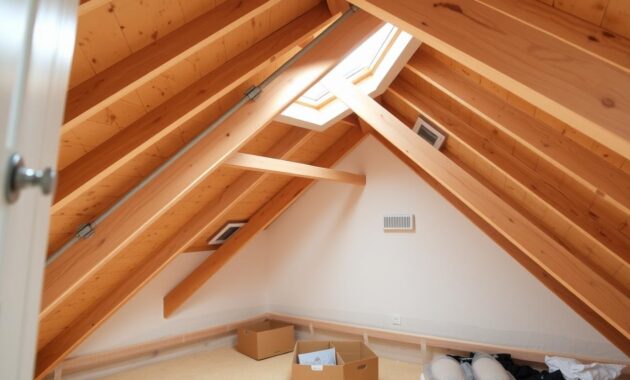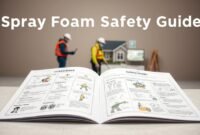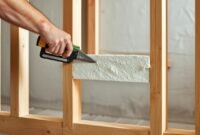Is your attic too hot in summer and too cold in winter? You’re not alone. Many homes struggle with poor attic insulation, causing high energy bills and uncomfortable living spaces.
Spray foam insulation for attic roofs is a game-changer for home energy efficiency. This guide will help you decide if it’s right for your home, covering the pros, cons, and more.
Key Takeaways
- Spray foam insulation can significantly reduce attic temperatures
- Open-cell and closed-cell foam options are available for attic insulation
- Professional installation is crucial for optimal performance and safety
- Spray foam can improve energy efficiency and HVAC performance
- Costs vary but long-term energy savings often justify the investment
Understanding Spray Foam Insulation for Attic Roofs
I’ve seen how spray foam insulation changes attic spaces. It’s a big help for saving energy and keeping things comfortable for a long time. Let’s look at the different types of spray foam and their benefits.
Read also: 5 Common Spray Foam Insulation Roof Problems
Open Cell vs Closed Cell Spray Foam
There are two main types of spray foam: open cell and closed cell. Each has its own advantages:
| Feature | Open Cell | Closed Cell |
|---|---|---|
| Density | Lighter | Denser |
| R-value per inch | 3.5 – 4 | 6 – 7 |
| Cost per sq ft | $1.50 – $2.30 | $1.20 – $1.50 |
| Moisture resistance | Lower | Higher |
R-Value Considerations
R-value is key for how well insulation works. Closed-cell foam keeps its R-value over time. Open-cell foam settles at about 3.5 per inch. For zones 1-3, aim for R-values between R39 and R60.
Cost Implications and Long-Term Benefits
Spray foam insulation costs between $0.5 and $2.5 per square foot. It’s more expensive at first, but it saves money in the long run. You’ll spend less on energy, breathe better air, and keep pests away. For a 1000 sq ft attic, expect to pay between $7340 and $8930 for closed-cell insulation.
Should I Spray Foam My Attic Roof: Making the Right Decision
I’ve been thinking about spray foam for my attic roof. It’s a big step for energy efficiency. In cold areas, it can lower heating needs by 10%.
Insulating with spray foam also fights air leaks. Air leaks in ducts can be over 20%. An unvented attic system keeps ducts sealed, boosting efficiency by 20%.
Choosing attic foam insulation means looking at upfront costs versus long-term savings. Proper installation is vital to avoid issues like mold. But done correctly, it prevents problems and even protects against fire and damage.
Here’s a quick rundown of benefits:
- Reduced heat loss/gain through mechanical equipment
- Better temperature control throughout your home
- Potential for significant cuts in energy bills
- Improved overall home comfort
Before deciding, I’m checking my attic’s condition and my goals. If you’re thinking about spray foam, it’s a big step towards better home energy.
Benefits of Converting to an Unvented Attic System
Changing your attic to an unvented system can greatly improve your home. I’ve seen how it can make living spaces better and more comfortable. Let’s look at the main benefits you’ll get.
Temperature Control Advantages
An unvented attic system keeps your home’s temperature steady. Spray foam insulation acts as a strong air barrier, stopping heat from escaping. This keeps your home cooler in summer and warmer in winter, avoiding the big temperature swings of vented attics.
Energy Efficiency Improvements
Unvented attics save a lot of energy. By sealing the attic, your HVAC system works less hard. This can cut your energy bills by up to 20%.
Impact on HVAC Performance
Your HVAC system will work better with an unvented attic. A well-insulated and ventilated space means your heating and cooling don’t have to work as hard. This boosts efficiency and can make your HVAC last longer.
| Aspect | Vented Attic | Unvented Attic |
|---|---|---|
| Temperature Control | Variable | Consistent |
| Energy Efficiency | Good | Excellent |
| HVAC Performance | Standard | Improved |
| Living Space Potential | Limited | Increased |
Switching to an unvented attic system does more than just save energy. It makes your home more comfortable and could even increase its value. It’s a smart choice that benefits you now and in the future.
Read also: Does Spray Foam Insulation Reduce Noise?
Proper Installation Requirements and Building Codes
I’ve learned that installing spray foam insulation right is key for it to work well and be safe. The International Residential Code (IRC) has rules for unvented attics. It makes sure insulation is put in correctly.
IRC Requirements for Unvented Attics
The IRC gives clear steps for using spray foam in unvented attics. Since 2004, the International Code Council has allowed this insulation. In zones 5-8, insulation must block air and be a Class II vapor retarder or have a special coating.
Fire Protection Standards
Fire safety is very important with spray foam. Building codes say there must be thermal barriers between foam and inside spaces. Ignition barriers are needed in attics and crawl spaces that people can get to. These rules make sure insulation is safe.
| Climate Zone | Insulation Requirement | Humidity Control |
|---|---|---|
| 5-8 | Class II vapor retarder | Below 35% RH |
| North Florida | R-13 closed-cell foam under floor | Not specified |
Professional Installation Guidelines
I suggest getting licensed pros for spray foam installation. They make sure it follows building codes and the maker’s rules. Before starting, clean the area and fix any moisture problems. Check that the foam is the right depth and there are no gaps.

Also, remember that HVAC systems in unvented attics need special duct layouts and balanced air systems. By following these steps, your attic insulation will be both effective and follow the rules.
Common Challenges and Solutions in Attic Spray Foam Projects
I’ve faced many problems with spray foam insulation in attics. Insulating attic spaces can be hard, and spray foam has its own challenges. Let’s look at some common issues and how to solve them.
Shrinkage is a big worry, especially in places with big temperature changes. Adding more foam or redoing the application can help. Missed spots during installation are another problem. To avoid this, it’s best to hire experienced pros who cover everything well.
Ventilation issues can arise if not done right during installation. It’s key to plan for good airflow to avoid moisture buildup. Also, fixing any water problems before applying spray foam is crucial. Ignoring this can cause bigger issues later.
| Challenge | Solution |
|---|---|
| Shrinkage | Add more foam or replace application |
| Missed areas | Hire experienced contractors |
| Ventilation issues | Plan for proper airflow |
| Moisture problems | Resolve before insulation |
Thickness inconsistency is another issue I’ve seen. In one project near Charleston, South Carolina, the foam was from zero to 9 inches thick. This unevenness can waste energy and affect comfort. To fix this, I always check the application and quality closely.
Preparing Your Attic for Spray Foam Installation
Getting your attic ready for spray foam insulation is crucial. It’s all about the right steps to save energy. Let’s explore how to prepare your attic for this upgrade.
Removing Existing Insulation
First, we must remove old insulation. This is important because older insulation can be harmful. I always hire experts for this job. They wear full-body suits and masks to stay safe.
Air Sealing Requirements
Then, we seal air leaks. I use expanding spray foam to fill gaps around windows and rooflines. This step is key to keeping your attic comfortable. Good air sealing and ventilation are essential for a healthy attic.
Ventilation Considerations
Finally, we think about ventilation. Spray foam can affect air flow in your attic. I make sure there’s enough space for the foam to expand. I also check local building codes to follow regulations.
| Insulation Type | R-Value | Thickness |
|---|---|---|
| Open Cell Foam (Attic) | R-19 | 6 inches |
| Closed Cell Foam (Walls) | R-13 | 2 inches |
| Closed Cell Foam (Attic) | R-21 | 3 inches |
By following these steps, I make sure my attic is ready for spray foam insulation. This preparation helps the installation go smoothly and boosts the insulation’s benefits.
Impact on Home Energy Performance and Comfort
I’ve seen how spray foam insulation changes homes. It’s a big improvement for energy use and comfort. Let’s look at how it affects your home.
Temperature Regulation
Spray foam makes a tight seal, blocking air 24 times better than other insulations. This keeps your home warm in winter and cool in summer. Your HVAC system won’t have to work as hard.
Moisture Control Benefits
Spray foam is great at keeping moisture out. It doesn’t attract mold or mildew. This means cleaner air and a healthier home. It also keeps allergens and pollutants out, improving air quality.
Energy Bill Reductions
Switching to spray foam can cut energy bills by 30% to 70%. It’s a big savings! The initial cost is higher, but the long-term savings are worth it. You’ll see lower bills right away, and the insulation lasts for decades.
| Feature | Spray Foam | Traditional Insulation |
|---|---|---|
| Energy Efficiency Increase | 30-70% | Varies |
| Lifespan | Decades | ~10 years |
| Moisture Resistance | High | Low |
| Air Sealing | Excellent | Poor to Fair |
Choosing spray foam insulation is smart for your home. It offers unmatched temperature control, moisture resistance, and energy savings. Although it costs more at first, the long-term benefits are huge.
Addressing Ventilation in Spray Foamed Attics
When I decided to spray foam my attic roof, I learned that ventilation is crucial even with this airtight insulation. Spray foam creates an effective air barrier in attic spaces, but proper ventilation remains essential. It prevents moisture buildup and maintains good indoor air quality.
For unconditioned attics, I found that traditional ventilation systems work well with spray foam. Ridge vents and soffit vents create a balanced airflow. Gable vents can also help hot air escape. In my case, I opted for a combination of ridge and soffit vents to complement the spray foam insulation.

For conditioned attics, the approach is different. The goal is to create a sealed environment that matches the temperature of living spaces. In these cases, humidity control becomes key. HVAC systems or vapor diffusion ports can manage moisture levels effectively.
| Attic Type | Ventilation Solution | Benefits |
|---|---|---|
| Unconditioned | Ridge and soffit vents | Balanced airflow, moisture control |
| Conditioned | HVAC or vapor diffusion ports | Temperature matching, humidity management |
I learned that proper ventilation extends roof life and prevents mold growth. It’s vital to consult a professional to determine the best strategy for your specific attic setup and local climate. With the right approach, spray foam insulation and ventilation work together to create an energy-efficient and comfortable home.
Maintenance and Long-Term Considerations
Thinking about spray foam insulation, I see its long-term benefits and upkeep needs. It lasts for decades if installed right, making it a wise choice for homeowners.
Durability Factors
The insulation type greatly affects durability. Closed-cell foam is stronger and more resistant to moisture than open-cell. Spray foam insulation is 50% more effective than materials like fiberglass.
Repair Access Issues
One challenge is the difficulty in repairs. Spray foam adheres strongly, making access hard. Regular inspections are crucial to catch problems early. Remember, fixing issues can be expensive – removing it from a three-bedroom house roof costs about $4,000.
Longevity Expectations
With proper installation, spray foam insulation can last over 20 years. This longevity is a big plus compared to other insulation types that may need to be replaced sooner. But, wrong installation can cause serious problems like condensation or fire risks.
| Insulation Type | Lifespan | R-Value per Inch |
|---|---|---|
| Closed-Cell Spray Foam | 20+ years | 6.0 – 7.0 |
| Open-Cell Spray Foam | 20+ years | 3.6 – 3.8 |
| Fiberglass | 15-20 years | 2.2 – 2.7 |
To get the best results, I always suggest hiring professionals for installation. This avoids costly errors and ensures your insulation works well for years.
Final Thoughts
After looking into spray foam attic insulation, I think it’s a big win for saving energy. Most inspections still focus on ventilation for standard insulation. But spray foam brings a fresh approach. In Florida, about 500 homes have already tried it, mostly using Icynene.
Read also: Can You Paint Spray Foam Insulation?
Some people might see this method as unusual. But it works well because it has high R-values. This means you can use less of it in tight spots. The closed-cell type has been reliable for ten years without any problems.
It’s important to know that spray foam attic insulation is more expensive than other options. But it can save you a lot on energy bills. The key is to install it right – no vents, a tight seal, and the right temperature controls are essential.
There are still questions about its long-term effects, like how it might affect future reroofing. But if you want to make your home more comfortable and efficient, spray foam is worth looking into. Always talk to local experts and follow the rules for the best outcome.


